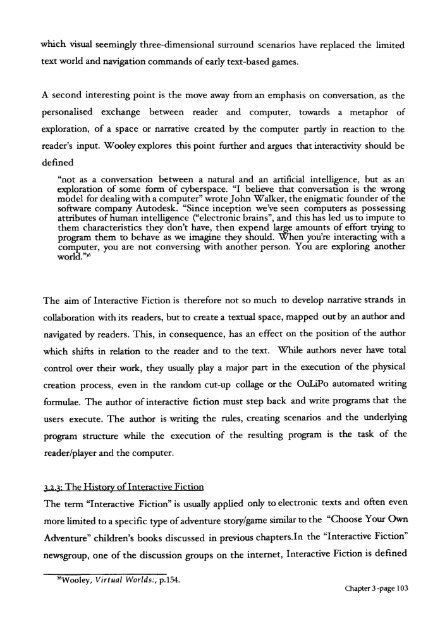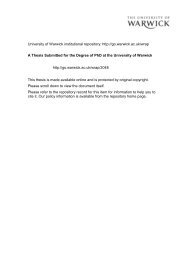From Page to Screen - WRAP: Warwick Research Archive Portal ...
From Page to Screen - WRAP: Warwick Research Archive Portal ...
From Page to Screen - WRAP: Warwick Research Archive Portal ...
Create successful ePaper yourself
Turn your PDF publications into a flip-book with our unique Google optimized e-Paper software.
which visual seemingly three-dimensional surround scenarios have replaced the limited<br />
text world and navigation commands ofearly text-based games.<br />
A second interesting point is the move away from an emphasis on conversation, as the<br />
personalised exchange between reader and computer, <strong>to</strong>wards a metaphor of<br />
exploration, of a space or narrative created by the computer partly in reaction <strong>to</strong> the<br />
reader's input. Wooley explores this point further and argues that interactivity should be<br />
defined<br />
"not as a conversation between a natural and an artificial intelligence, but as an<br />
exploration of some form of cyberspace. "I believe that conversation is the wrong<br />
model for dealingwith a computer" wroteJohn Walker, the enigmatic founder of the<br />
software company Au<strong>to</strong>desk. "Since inception we've seen computers as possessing<br />
attributes ofhuman intelligence ("electronic brains", and this has led us <strong>to</strong> impute <strong>to</strong><br />
them characteristics they don't have, then expend large amounts of effort trying <strong>to</strong><br />
program them <strong>to</strong> behave as we imagine they should. When you're interacting with a<br />
computer, you are not conversing with another person. You are exploring another<br />
world."><br />
The aim of Interactive Fiction is therefore not so much <strong>to</strong> develop narrative strands in<br />
collaboration with its readers, but <strong>to</strong> create a textual space, mapped outby an author and<br />
navigated by readers. This, in consequence, has an effect on the position of the author<br />
which shifts in relation <strong>to</strong> the reader and <strong>to</strong> the text. While authors never have <strong>to</strong>tal<br />
control over their work, they usually playa major part in the execution of the physical<br />
creation process, even in the random cut-up collage or the OuLiPo au<strong>to</strong>mated writing<br />
formulae. The author of interactive fiction must step back and write programs that the<br />
users execute. The author is writing the rules, creating scenarios and the underlying<br />
program structure while the execution of the resulting program is the task of the<br />
reader/player and the computer.<br />
3,2,3; The His<strong>to</strong>ry ofInteractive Fiction<br />
The term "Interactive Fiction" is usually applied only <strong>to</strong> electronic texts and often even<br />
more limited <strong>to</strong> a specific type ofadventure s<strong>to</strong>ry/game similar <strong>to</strong> the "Choose Your Own<br />
Adventure" children's books discussed in previous chapters.In the "Interactive Fiction"<br />
newsgroup, one of the discussion groups on the internet, Interactive Fiction is defined<br />
36Wooley, Virtual Worlds:, p.l54.<br />
Chapter 3 -page 103





